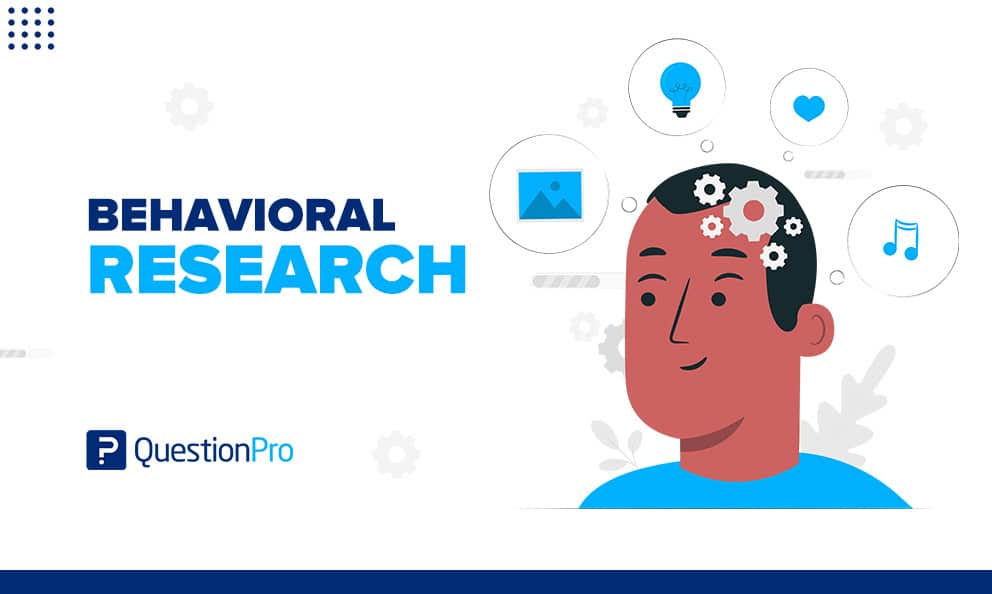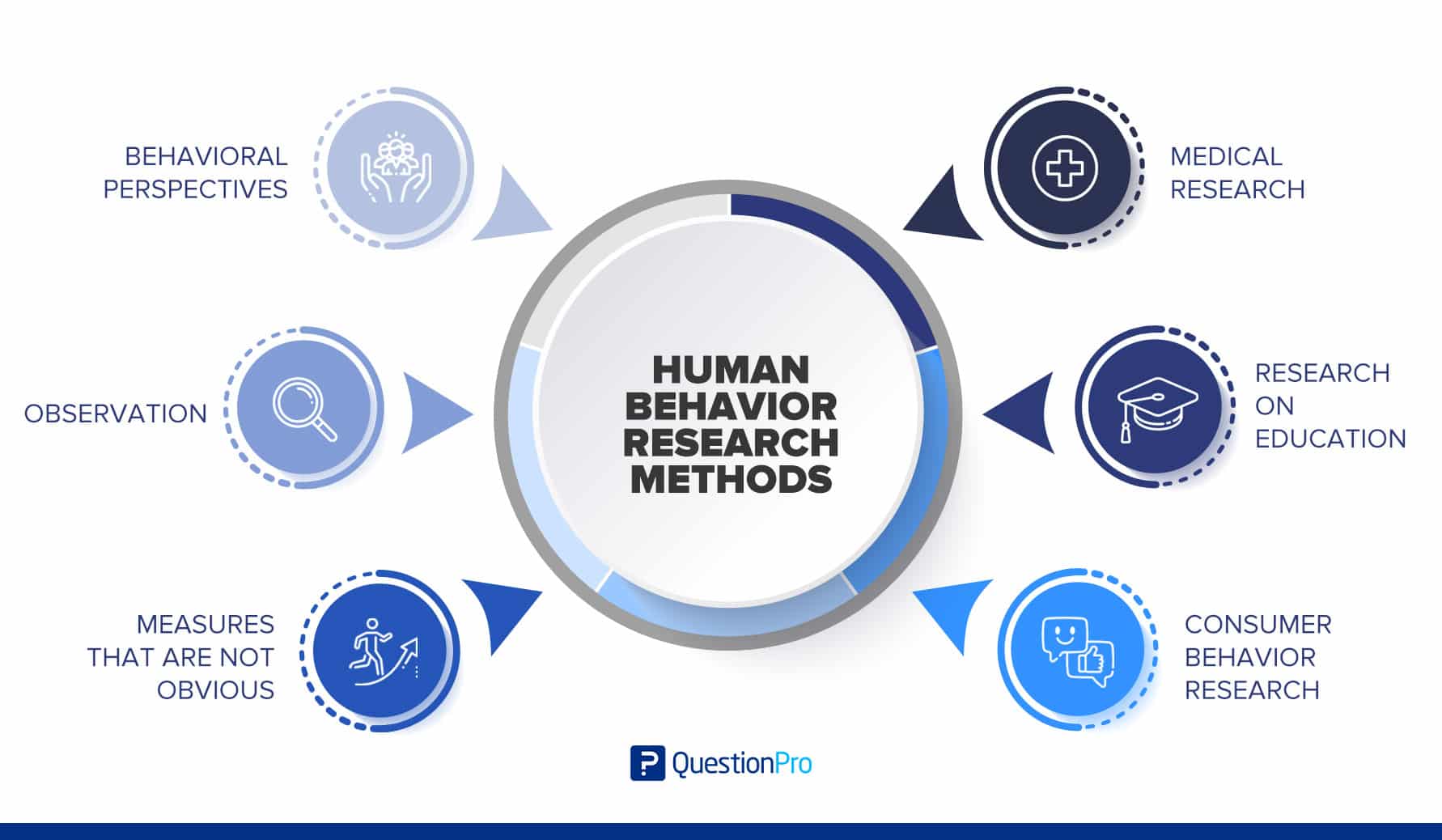
Regardless of whether we like it or not, our histories, habits, and emotions all have a significant part in our behavior. Behavioral research uses measurement and interpretation to explore and comprehend individual and societal behavior. In this blog, we’ll discuss why behavioral research is important and the methods to do it.
LEARN ABOUT: Research Process Steps
What is Behavioral Research?
Behavioral research is the combination of quantitative and qualitative methods to measure human behavior, get new data, and analyze the effects of active treatment situations on human behavior.
Human behavior fascinates a lot of people. What causes our behavior? What influences or measures our behavior? And why is it so tough to change one’s behavior?
Human behavior research has played a significant role in uplifting the livelihoods of people suffering from mental illnesses and behavioral disorders. It has also assisted breakthroughs in child development, organizational culture monitoring, and public health. Professionals interested in learning how to analyze human behavior want to comprehend why individuals make decisions to better grasp the decision-making process.
What Is the Importance of Behavioral Research?
Applied behavior analysis (ABA) is a behavioral science subject that studies behavior principles, learning, motivation, and strategies for changing behavior. Schools, clinical services, and behavioral health institutions are among the places where applied behavior analysts can work.
Their job includes designing and implementing behavior modification strategies based on observation and data analysis. Counseling, psychology, and special education are also specializations that are certainly part of applied behavior analysis.
Human behavior research spans a wide range of scientific and social disciplines. Behavioral science is defined by the American Psychological Association as any subject (for example, psychology, sociology, or anthropology) that uses experiments and observation to explore human and nonhuman actions and reactions in a scientific manner.
Behavioral science includes a wide range of fields, including Anthropology, economic behavior, psychology of cognition, consumer behavior, psychology of social interaction, and sociology.
Some behavioral scientists combine ideas, concepts, and approaches from several fields to fully comprehend the complexities of human behavior.
Behavioral scientists investigate why humans sometimes act in ways that are detrimental to their well-being. They look at how random environmental influences shape our choices, beliefs, and attitudes. Researchers are also looking at how customers might be enticed to accept, avoid, or adjust their buying decisions.
LEARN ABOUT: 12 Best Tools for Researchers
Human Behavior Research Methods
1. Behavioral perspectives
According to behaviorists, all behaviors are learned via experience and are learned through contact with our environment. Classical and operant are two key ideas in learning new behaviors.
Something fresh is combined with something natural in classical conditioning. After some time, the new stimulus elicits the same reaction as the previous stimulation, leading to a new association.
Comparing qualitative and quantitative research
All sorts of research devices are available to measure human behavior. These tools are classified as qualitative or quantitative research measures.
LEARN ABOUT: Qualitative Interview
- Qualitative research
By examining underlying causes, beliefs, and motives, qualitative measures assist researchers in better understanding human behavior. It aims to explain “how” and “why” individuals act the way they do.
In-depth conversations, focus group discussions, observations, and unstructured surveys with open-ended questions are examples of qualitative data measurement methods. Qualitative research should ideally be performed in a natural situation.
LEARN ABOUT: Qualitative Research Questions and Questionnaires
- Quantitative research
Quantitative measures, on the other hand, are used to measure preferences, views, facts, actions, and other types of analyzed data and to apply results from a broader sample group. This is used to provide numerical responses to inquiries such as “How many?”, “How often?”, and “How much?”
Surveys, structured questionnaires, and internet polls with closed-ended questions are examples of methods for gathering this information.
2. Observation
Making observations is a crucial element of researching human behavioral research. What better method to understand someone’s actions than to observe them? What interactions does your test participant have with a kid, a patient, or a computer?
Observational research is usually done at home, work, or in a specially equipped observation lab. Unobtrusive observation is the greatest technique to see one’s genuine conduct.
Another technique to observe someone’s behavior is to examine the inside of them, especially their brain. Because most of the activities that happen inside are not visible to all of us, studying brain activity can provide fresh insights into human behavior.
When researching a wounded brain and the impact it has on a patient, we can see connections between behavior and brain activity. In certain circumstances, brain evidence aids in the resolution of long-standing psychological riddles.
3. Measures that are not obvious
While questionnaires are excellent for gathering ideas, personality traits, and (mental) health concerns, they do have significant drawbacks.
Approximately 95% of our actions are unconscious and automatic. Researchers have devised methods to record our subconscious thoughts, feelings, and actions. Indirect tests demand that people react quickly to a variety of inputs. Differences in reaction times reveal how you feel about something or someone.
4. Medical research
It’s all about the quality of life and, as a result, quality of care in the medical field of care research. According to Wikipedia, “well-being quality of life” assesses how a sickness, disability, or ailment may impair an individual’s well-being over time. The greatest goal of healthcare providers is to improve their patient’s quality of life by delivering the most acceptable available treatment.
Doctor-patient contact, operating room architecture, simulation training, team effectiveness and communication, and coping with emotions are all possible themes for healthcare research. All of these factors influence quality care and, hence, life.
5. Research on education and training
Through education, students learn facts, events, values, ideas, basic concepts, principles, and other things. Training, on the other hand, is a method of acquiring abilities rather than simply learning facts. Training is focused on practical application, including hands-on experience. They assist individuals in implementing a new system, improving a particular ability, or advancing their proficiency in anything.
Education and training may occur in a variety of professions and places, including classrooms and skills laboratories. In a safe, controlled atmosphere, the theory may be put into practice.
6. Consumer behavior research
The most incredible method for understanding customer decision behavior and preferences is identifying the target audience. How do customers interact with a product? Why did they decide to purchase the item in the first place? Was it because of the packing or the layout of the store? Or were there any unconscious emotions at play?
LEARN ABOUT: Action Research
Conclusion
Human action is a multifaceted and dynamic topic of behavioral research study that necessitates several lines of inquiry to provide insights. Learning processes set the framework for deciding many of our actions. However, we are constantly evolving in reaction to our environment.
Understanding our actions is a complex undertaking, but it is one that we are coming closer to completing. Traditional research approaches have taught us a lot, and now detection methods can guide us.
LEARN ABOUT: Theoretical Research
Get the most out of your research data management.
With QuestionPro, you can access the most mature market research platform and tool that helps you collect and analyze the insights that matter the most. By leveraging InsightsHub, the unified hub for data management, you can leverage the consolidated platform to organize, explore, search, and discover your research data in one organized data repository.
LEARN ABOUT: Data Management Framework








